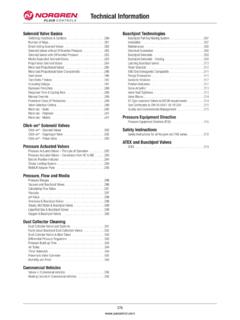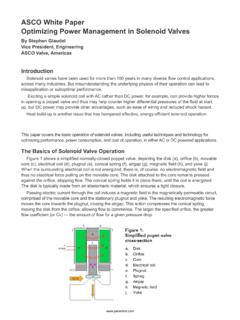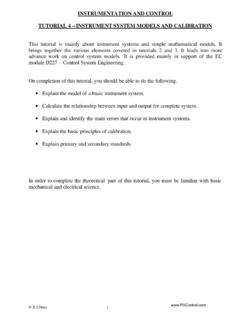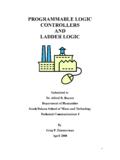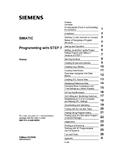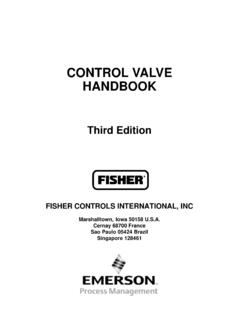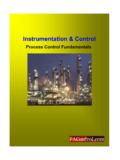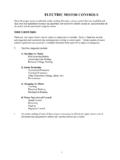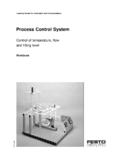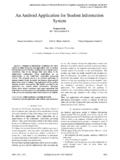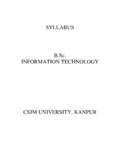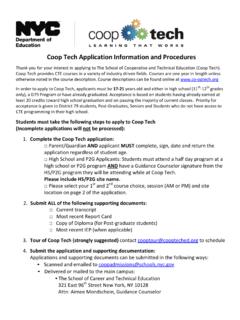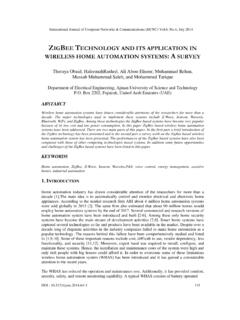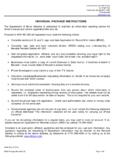Transcription of PROFIBUS Technology and Application - …
1 System DescriptionOpen Solutions for the World of AutomationPROFIBUST echnology and Application02092 PNO Titel AR1 11:14 Uhr Seite 1 Commitment We are and will remain the world s leading organi-zation in the field of digital networking for industrialand process automation, serving our customers,our members and the press with the best solu-tions, benefits and information. We are committed to setting and protecting thestandards for open communication and control inthe automation and process market. Introduction From the outset, the field of auto-mation has been subject to con-tinuous change. Not so long ago, this change was limited to the pro-duction area of a company. In pro-duction, the implementation of fieldbus Technology has meant considerable innovation, enabling the migration from centralized to decentralized automation systems.
2 This has been the PROFIBUS ob-jective for more than 10 years. In those 10 years PROFIBUS has become the world market leader in fieldbus Technology . In spite of the outstanding success of recent years, PROFIBUS development continues with undiminished en-thusiasm and energy. Initially the focus was on communication tech-nology. Current activities center around system integration, engi-neering and, in particular, the ap-plication profiles. These profiles have made PROFIBUS the only fieldbus that provides comprehen-sive both factory and process automation. Additionally, Information Technol-ogy (IT) increasingly determines development in today s world of automation. Modern fieldbus sys-tems have adopted IT principles and are achieving greater consis-tency with the corporate manage-ment level.
3 In this respect, indus-trial automation is following the de-velopment trends of the office world, where IT has long since left its mark, radically transforming in-frastructure, systems and proc-esses. The integration of informa-tion Technology in the world of automation opens up many new prospects for global data commu-nication between automation sys-tems. In pursuit of this objective, PROFIBUS is enhanced by the Ethernet-based communication standard PROFInet. The use of open standards rather than proprietary solutions ensures long-term compatibility and ex-pandability - in other words - pro-tection of existing investment. This is a matter of key importance to the PROFIBUS User Organization. The continuous development of PRO-FIBUS Technology provides members with a long-term perspec-tive.
4 Contents 1. Communication in Automation ..1 Industrial Fieldbus Technology Terms ..2 International 2. PROFIBUS at a History ..4 Market Position ..4 Organization ..4 The PROFIBUS Tool Box ..5 PROFIBUS - The keys to success ..6 3. PROFIBUS Transmission and Communication ..7 Transmission Technology ..7 Communication Protocol DP ..10 4. General Application Profiles ..17 PROFI safe ..17 HART on PROFIBUS DP ..17 Time Slave Redundancy ..18 5. Specific Application Profiles ..19 PROFI drive ..19 PA Fluid Power ..21 SEMI Ident Systems ..22 Remote I/O for PA ..22 6. System 23 7. Device Management .. 25 GSD .. 25 EDD ..26 FDT/DTM Concept ..27 8. Quality Assurance .. 28 Test 28 Conformance 28 9. Implementation .. 29 Standard 29 Implementation of 30 10. PROFInet .. 31 The PROFInet Engineering Model .. 31 The PROFInet Communications 32 The PROFInet Migration Model.
5 32 XML .. 32 OPC and OPC DX .. 32 11. PROFIBUS 33 ContentsThis document describes the es-sential aspects of PROFIBUS and takes into account the level of Technology available at the end of 2002. Its objective is to provide a comprehensive description of the world's leading fieldbus system, PROFIBUS , without becoming too engulfed in specific details. This brochure not only offers suffi-cient information to those with a basic knowledge and readers in-terested in an overview, but it also introduces experts to more exten-sive specialized literature. In this context, we would like to point out that, in spite of the care that has been taken in the preparation of this overview, only the PROFIBUS documents available on the Inter-net are definitive and binding. Please refer to them for more de-tailed information.
6 Chapters 1 and 2 offer an intro-duction to the principles of fieldbus Technology and their implementa-tion with PROFIBUS . Chapters 3 to 6 deal with the core aspects of PROFIBUS and any repetition of subject matter dealt with in Chapter 2 is intentional for reasons of completeness. These chapters emulate the modu-lar layout of PROFIBUS , from communication Technology through Application profiles to system pro-files. Chapters 7 to 9 are more practi-cally oriented. They deal with sub-jects such as device management, implementation and certification. Chapter 10 presents the theory of operation of PROFInet. Chapter 11 completes the bro-chure with details of PROFIBUS In-ternational and the PROFIBUS User Organization. PROFIBUS Technology and Application , October 2002 11. Communication in Automation The communication capability of devices and subsystems and con-sistent information methodology are indispensible components of future-oriented automation con-cepts.
7 Communications are in-creasingly occuring horizontally at the field level as well as vertically through several hierarchical levels simultaneously. Layered and coor-dinated industrial communication systems, such as PROFIBUS with lower-level interfacing to AS-Interface and upper level interfac-ing to Ethernet (over PROFInet) (see Figure 1), offer ideal precondi-tions for transparent networking in all areas of the production process. Industrial Communication At the sensor-actuator level signals of binary sensors and ac-tuators are transmitted over a sen-sor actuator bus. This provides a simple and cost-effective technol-ogy where data and power are transmitted over a shared medium. AS-Interface offers a suitable bus system for this field of Application . At field level distributed devices such as I/O modules, transducers, drive units, analysis devices, valves or operator terminals, com-municate with automation systems over a powerful, real-time commu-nication system.
8 Transmission of the process data is cyclic, while additional interrupts, configuration data and diagnosis data are trans-mitted acyclically as required. PROFIBUS fulfills these criteria and offers an universal solution for both factory and process automa-tion. At the cell level programmable controllers such as PLCs and IPCs, communicate with each other and with IT systems of the office world using standards such as Ethernet, TCP/IP, Intranet and Internet. This information flow requires large data packets and a range of powerful communication functions. As well as PROFIBUS , Ethernet-based PROFInet offers a trendset-ting solution for this purpose. In the following PROFIBUS will be described in detail as the central connecting link for the information flow in the automation industry. For information on AS-Interface please reffer to the relevant literature.
9 Fur-thermore PROFInet will be briefly presented in chapter 10. Fieldbuses are industrial com-munication systems that use a range of media such as copper ca-ble, fiber optics or wireless, with bit-serial transmission for coupling distributed field devices (sensors, actuators, drives, transducers, etc.) to a central control or management system. Fieldbus Technology was developed in the 80s with the aim of replacing the commonly used central parallel wiring and prevail-ing analog signal transmission (4-20 mA- or +/- 10V interface) withdigital Technology . Due, in parts, to the different industry-specific demands and preferred proprietary solutions of large manu-facturers, several bus systems with varying properties were established in the market. The key technolo-gies are now included in recently adopted standards IEC 61158 and IEC 61784.
10 PROFIBUS is an inte-gral part of these standards. Recently, Ethernet-based commu-nication systems have emerged in industrial automation. They offer wide-ranging options for communi-cations between the different levels of industrial automation and the of-fice world. PROFInet is an example of one such Ethernet-based com-munication system. A need for the coordinated devel-opment and distribution of these fieldbus systems in the market has seen the emergence of a number of User Organizations comprising manufacturers, users and insti-tutes, such as the PROFIBUS User Organization (PNO) and its parent organization PROFIBUS Interna-tional (PI) for PROFIBUS and PROFInet technologies. User benefits are the motivation for the emergence and continual development of fieldbus technol-ogy. This ultimately manifests itself as a reduction of the total cost of ownership, as well as an increase in performance and quality im-provement during the setup and operation of automation plants.
